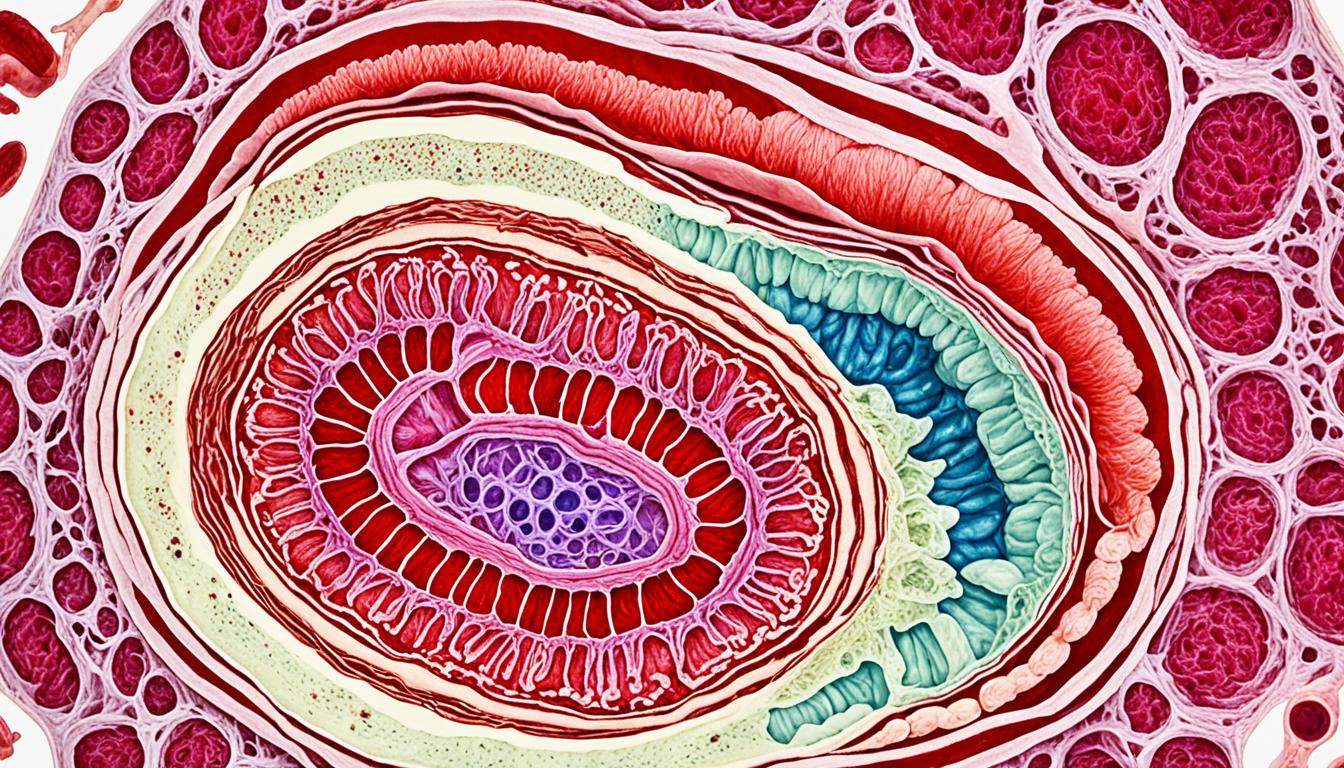Congenital megacolon, or Hirschsprung’s disease, is a type of birth defect. It affects the large intestine by causing a lack of ganglion cells. This makes bowel movements abnormal. It is not common but happens in about 15% of kids who need surgery right after birth.
Children with this disease find it hard to pass stool and may not feel like eating. They may grow slowly and face serious gut problems. Doctors find it through exams and special tests like X-rays and taking a small piece of the colon to look at under a microscope.
Luckily, surgery can fix congenital megacolon in most cases. There is also hope in stem cell therapy for some patients. These new treatments offer more chances for a complete cure.
Key Takeaways:
- Congenital megacolon, also known as Hirschsprung’s disease, affects the large intestine.
- The absence of ganglion cells in the enteric nervous system is the main cause of congenital megacolon.
- Symptoms include difficulty in defecation, anorexia, slow growth, and potential complications.
- Diagnosis involves clinical examination and tests such as X-ray and colon tissue biopsy.
- Surgical intervention and stem cell therapy offer effective treatment options.
Treatment Options for Congenital Megacolon
The treatment for congenital megacolon considers how serious the problem is. It looks at the patient’s health. Treatment options include managing with medicine or surgery. For mild symptoms like constipation in kids or baby bowel blockages, medicine might be enough.
For more severe cases requiring surgery, the doctor must remove the bad part of the intestine. Then, they join the healthy part to the anus. This improves the bowels’ function.
Surgery time varies for each patient. Thanks to better surgery techniques, most people need only one surgery. This means fewer hospital visits. After surgery, some may face bowel issues but these problems get better with time.
Check-ups are crucial after surgery. They ensure everything is healing well. To help their bowels work better, patients must eat healthy and drink enough water. Doing so, along with creating good toilet habits, can stop constipation.
Surgical Treatment for Congenital Megacolon
For congenital megacolon with a blockage, surgery is key. The goal is to remove the bad part of the intestine. This helps return bowel movements to normal and eases constipation and blockages.
Various surgical methods exist, such as:
- Pull-through procedure: This is a common surgery. It removes the bad part of the intestine and attaches the healthy part to the anus. Stool can flow normally again, solving the blockage problem.
- Ostomy procedure: Sometimes, a stoma is needed. A stoma helps by letting stool leave the body through the belly, into a special bag. This is temporary. After healing, another surgery closes the stoma.
The surgery type chosen depends on the patient. How severe the condition and where the blockage is matter. The expert team picks the best approach for each case for a successful result.
Stem Cell Therapy for Congenital Megacolon
Stem cell therapy is changing how we deal with congenital megacolon. This is especially true for babies with congenital intestinal aganglionosis. It’s a new hope for those dealing with this serious bowel problem.
Doctors hope to use stem cells to fix the colon issues in newborns. Right now, this method is still in the research phase. But, it shows a lot of promises for the babies who might need it in the future.
This therapy aims to fix the main problem in congenital megacolon. By helping the digestive system heal, it could mean big things for babies born with this tough health issue.
FAQ
Q: What is congenital megacolon?
A: This condition, also known as Hirschsprung’s disease, affects the large intestine from birth. It happens because there aren’t enough nerve cells in the digestive system. This leads to problems moving food and waste through the body.
Q: What are the symptoms of congenital megacolon?
A: Signs of this condition can include trouble using the bathroom, feeling like not eating, growing slowly, and sometimes, belly pain or blockages in the intestines.
Q: How is congenital megacolon diagnosed?
A: Doctors will do a check-up and use tools like X-rays to look inside. They might also take tiny samples of the colon for testing.
Q: What are the treatment options for congenital megacolon?
A: The right treatment varies for each person based on how serious it is. Main options are medicines and sometimes an operation.
Q: Can congenital megacolon be cured?
A: Thanks to medical progress, it’s possible to fully treat it with surgery. For some, stem cell therapy is a new approach that might help.
Q: What is the recovery process after surgery for congenital megacolon?
A: After surgery, some might deal with bowel problems, like leaks or constipation. They need to see their doctor often for advice and to check how they are doing.
Q: What dietary adjustments are recommended for postoperative care of congenital megacolon?
A: It’s advised to eat more fiber, whole grains, veggies, and fruits. It helps to drink plenty of water and keep your bathroom schedule regular.
Q: What is stem cell therapy for congenital megacolon?
A: This new treatment focus is promising, especially for those with severe cases of the disease. It aims to use stem cells to grow the needed nerve cells in the intestines.
Q: Is stem cell therapy widely available for the treatment of congenital megacolon?
A: Even though it’s not common yet, ongoing studies are excited about its future benefits. It could offer better treatments for newborns with the condition down the line.

